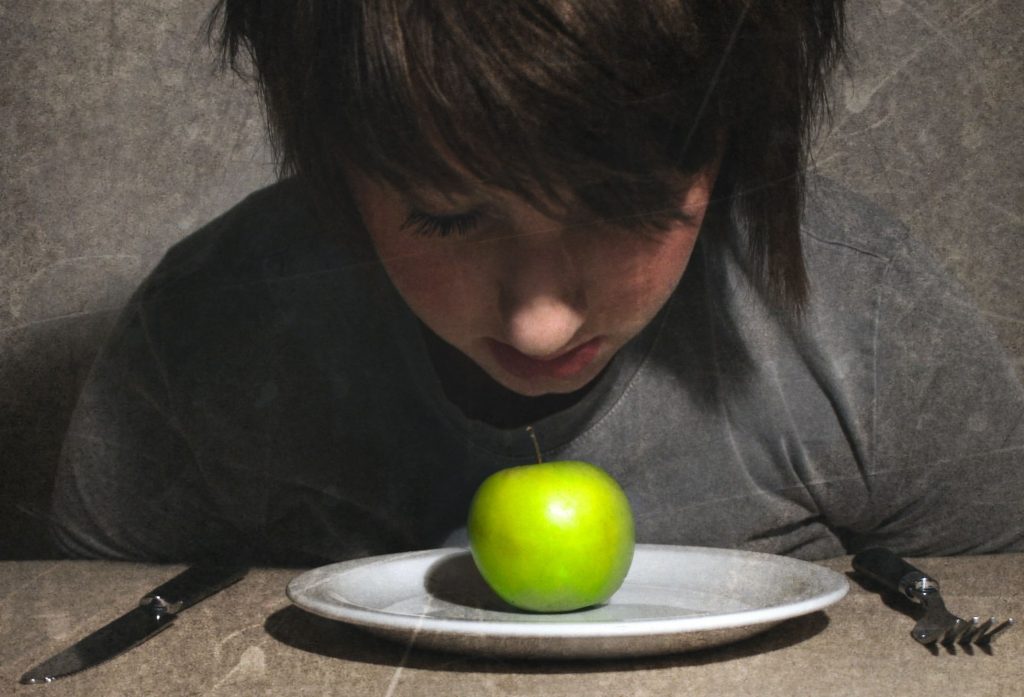Anorexia’s Deadly Deceit

When I was between the ages of 17 and 20, I could only eat lunch at 1 p.m.; it seemed the world would end if I didn’t. I waited for the exact hour and minute to prepare and eat each meal, regardless of whether my hunger pangs had set in hours before. So when the clock chimed 12:45, my ears would perk up like a hound dog’s on a hunt. Then I would tiptoe downstairs, doing everything possible to avoid attracting attention, and prepare my lunch.
But I couldn’t just eat—the kitchen had to be immaculate. First, I would wash my hands and wipe down the countertop until it gleamed. By this point, I would be in a near-meditative state. My mind would be what I can only describe as “white”; I couldn’t think of anything nor could I feel anything except this blank, fiery nothingness surging through the back of my skull.
Lunch usually consisted of salad. I would choose three different vegetables or fruits. The first thing I would do was smell the items for freshness and run my fingers over them—a process that filled me with a mixture of delight and disgust. “These are pure enough,” I used to say to myself. Then I would go about washing each one, cutting them in a set order, weighing each portion, and methodically arranging the foods on a plate.
At 1 p.m., I would begin the thoughtful act of eating, taking time to chew and to mix flavors, colors, and textures. The bone-like crunch of a crisp pepper and the meatiness of mushrooms—these were at once a symphony and a dirge on my tongue. I slowly and intentionally sipped water between each bite.
Anorexia is an all-too-familiar but deeply misunderstood condition. At the same time that journalists, doctors, and other health care professionals harp on the dangers of the fashion industry or of diet fads, images of scantily clad young women with jutting hipbones and gaunt torsos are voyeuristically and prominently splashed across magazine racks and broadcast on television shows and ads. The common refrain is that these images of near skeletons are the consequences of a society that conditions women to feel that they must be thin in order to be attractive, to be worthy of any kind of attention at all.
Doctors often prescribe treatments that reinforce rather than cure eating disorders.
But this fixation on the body and the pursuit of an ideal disregards how anorexia is experienced by its victims. Medical professionals and the media often interpret the disordered eating habits associated with anorexia as simply the pursuit of an unhealthy weight. This misguided viewpoint takes no heed of the manner in which those with anorexia perceive and experience food—both alone and with others. As a result, doctors often prescribe treatments that reinforce rather than cure eating disorders.
Today, clinicians largely favor outpatient programs. But in one traditional inpatient program described by anthropologist Megan Warin in her book Abject Relations, patients eat alone. Staff claim that this helps the patients focus solely upon eating. Such isolation—especially surrounding eating practices—bolsters and reproduces anorexic tendencies rather than inhibiting them, notes Warin. In the same program, patients with eating disorders were isolated in single rooms and disciplined through a restriction of “privileges,” such as visitors and phone calls, if caught out of their beds—as if they were naughty school children. The explanation for their bedridden state was that it would help patients preserve energy.
My own experience of anorexia, which I suffered with for about four years, combined with my readings on eating disorders within the anthropological literature, gives me a unique window into the condition. I argue that rather than approaching the disease as an overriding obsession with being thin, doctors, therapists, and nutritionists should start to investigate how sufferers of anorexia experience food and the act of eating.
Anorexia is not so much an obsession with body image as it is a toxic relationship with others and with oneself. People with the condition often eschew relationships with anything other than their anorexia, perceiving them as a source of pollution. Thus, for example, rather than viewing eating together as a means of expressing relationships—like many cultures have perceived it throughout history—most anorexia sufferers experience eating communally as defiling. And so, like food, family and friends must be purged out of their lives.
The only relationship allowed, the one with anorexia, is at once friendly and hostile. People with anorexia sometimes give their condition a name, making it even more real and tangible. For anorexia sufferers, the most common personification is “Ana.” (People with bulimia often name their condition “Mia.”) Anorexia’s presence is something that comforts and provides a sense of identity and structure, like a best friend; yet the condition is simultaneously an arch nemesis, berating the person’s decisions, appearance, and actions. What those with anorexia most often want is to be perfect, pure, and clean. The problem is that this quest never ends—the sufferer searches in vain for this unattainable, idealized state.
Society’s focus on whether foods are “good” or “bad” for us marks food in certain ways.
This idealization, when intermingled with today’s discourse around food, leads those with anorexia to a problematic experience with food. Society’s focus on whether foods are “good” or “bad” for us marks food in certain ways. If it is low-calorie and contains hardly any fat (or only “good” fats) then it is oftentimes labeled “good.” We’re told to eat five portions of fruits and vegetables a day. We’re advised to “eat colorfully.” Healthy foods are “good” foods.
But to someone with anorexia, to eat “good” food typically means to eat “perfectly.” Food and eating become moral acts—things that can ennoble you and degrade you.
I always felt a discord when I touched food. It would please and repulse me. Most sufferers of anorexia experience food as polluting rather than nourishing. This is true even for “good” foods. But “greasy” or “fatty” food is so contaminating—so repulsive—that some feel, while paradoxically knowing it is impossible, that even smelling fatty, greasy foods allows these substances to enter and taint the body. Some anorexia sufferers wear rubber gloves if they are forced to prepare something they experience as “greasy” or “fatty.” I vividly remember one incident where I scrubbed my hands for 10 minutes after accidentally touching butter.
The British television program Doctor Who perfectly portrayed, with its depiction of aliens called the Adipose, the way that many anorexia sufferers experience fat. The Adipose were little marshmallow-shaped humanoid blobs of fat that emerged from the fatty tissue of living humans, at which point they began to run around Earth, terrifying human beings.
For those with an eating disorder, fat is given a monstrous, almost anthropomorphic portrayal. Fat is visible. You can see it sliding around a pan, as white chunks between slivers of red meat; you can pinch it and pull at it in your arms, legs, and behind. Fat is not the opposite of thinness—rather it is a tangible something, felt and experienced, to be avoided at all costs.
Some scholars, such as anthropologist Caroline Giles Banks and historian Rudolph Bell, have argued that anorexia may have cultural ties to the practices and values of Judeo-Christian religious men and women who lived during the medieval period. These people fasted, or only drank water and ate bread at set points during the day, to attain purity. There may be a grain of truth in this line of thought. After all, the religions that once held sway over the societies in which anorexia is now prevalent taught that through hard work and the denial of the body a person could attain purity and be clean.
Whatever anorexia’s historical origins, this conceptual connection to religious asceticism reveals a central truth: Anorexia is not simply about being thin. It is not necessarily a response to the media’s imposition of warped standards of beauty. It is not only a remnant of a puritanical society. Seeing anorexia as merely a fixation on maintaining an unhealthy weight silences sufferers.
Instead of turning those with anorexia into objects to be gawked at, we should be asking them how they experience their eating disorders—and what they think about food and why. These “insider” understandings can aid those who work to help people overcome their eating disorders, and they can also help all of us understand the lived realities of this disease. When people with anorexia are heard—and treated with the respect they deserve—we can all work together to silence anorexia’s authoritarian voice.
































